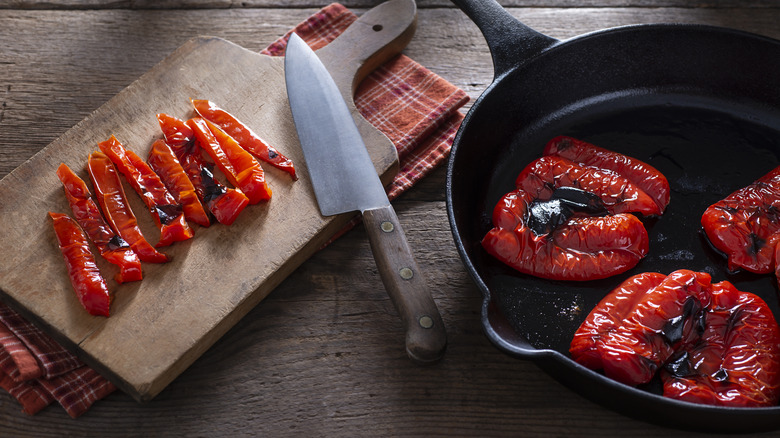Roasted Red Peppers Add A New Depth Of Flavor To Your Hummus
There's no arguing that hummus is one of the greatest culinary creations known to mankind — and its uses know no bounds. Made from a blend of chickpeas, quality tahini, lemon juice, extra virgin olive oil, and garlic, plain hummus is as equally as delicious as a dip as it is blended into soup, pasta sauce, and salad dressings. When it comes to hummus, "plain" or "original" is basically synonymous with multi-purposeful. Still, the addition of flavors can take it, and whatever you use it in, to different dimensions.
You can find many inspiring hummus flavor combinations sitting on the stands at your local farmers market and the shelves of your friendly neighborhood Middle-Eastern food shops, but there's one flavor you'll find anywhere you go: roasted red pepper. Roasted, skinned, and thrown into the food processor with the rest of your usual hummus ingredients, red peppers add a bold depth of flavor that will have you dipping and spreading everything in sight.
Making roasted red pepper hummus at home
While you can always grab a container of red pepper Sabra or Cedar's from the grocery store, there's something to be said about the kind you'd find from the farmers market or a Middle-Eastern specialty store. Whether it's the ingredients or the preparation, most of the time, grocery store hummus doesn't quite deliver the same creamy texture. But, of course, the next best thing to fresh hummus is the kind you make at home. Fortunately, even with the addition of the roasted red peppers, it's fairly easy to execute.
As with all hummus you make at home, the flavor and texture of red pepper hummus really comes down to the ingredients. Most importantly, you'll want to pick up a quality tahini. But before you start mixing it with the rest of your ingredients, you'll need to start by charring a couple of red peppers. The quickest way to do this is by using the broiler in your oven or cooking the pepper directly over the flame on your stovetop. The key here is to burn the skin so that, once they've cooled down, you can remove it for extra creaminess.
With the skins removed, add the peppers to your food processor along with any other ingredients your hummus recipe calls for, then blend, and dip away. If you want, you can also mix it into your tomato-based soups and pasta sauces for that extra bit of creaminess and deep red pepper flavor.

